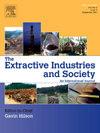高风险职业中心理健康的性别维度:对采矿和采掘部门的系统审查
IF 4.3
2区 社会学
Q2 ENVIRONMENTAL STUDIES
Extractive Industries and Society-An International Journal
Pub Date : 2025-06-19
DOI:10.1016/j.exis.2025.101710
引用次数: 0
摘要
目的本系统综述探讨了采矿和采掘部门的性别动态如何影响心理健康结果。它综合了经验证据,以确定社会心理风险、特定性别的脆弱性和职业卫生框架中的差距。方法:根据PRISMA指南,我们分析了2000年至2024年间发表的15篇同行评议的实证研究,这些研究来自5个主要数据库。资格标准包括关注采矿工人的心理健康,并将性别作为一个中心或交叉变量。研究从三个方面进行审查:方法特征、分析重点(结果、风险、工具)和关键发现。使用CASP和START工具对质量进行评价。结果:采矿工作一直与不良心理健康结果相关,包括抑郁、焦虑和心理困扰。社会心理风险——如工作与家庭冲突、骚扰、工作不安全感和组织不公正——对女性来说更为严重。性别分析的应用不一致,很少有研究提出干预措施。定性研究提供了对结构性不平等的见解,而定量研究提供了患病率数据,但往往缺乏交叉深度。结论:采掘业的心理健康风险受职业、文化和制度因素的影响,具有深刻的性别差异。改善采矿业的心理健康政策需要对性别问题有敏感认识的做法、包容性做法,并投资于针对不同采矿业情况的纵向参与性研究。本文章由计算机程序翻译,如有差异,请以英文原文为准。
Gendered dimensions of mental health in High-Risk occupations: A systematic review of the mining and extractive sectors
Objective
This systematic review examines how mental health outcomes are shaped by gendered dynamics in mining and extractive sectors. It synthesizes empirical evidence to identify psychosocial risks, gender-specific vulnerabilities, and gaps in occupational health frameworks. Methods: Following PRISMA guidelines, we analyzed 15 peer-reviewed empirical studies published between 2000 and 2024, retrieved from five major databases. Eligibility criteria included focus on mental health among mining workers and incorporation of gender as a central or intersecting variable. Studies were examined across three dimensions: methodological characteristics, analytical focus (outcomes, risks, instruments), and critical findings. Quality was appraised using CASP and START tools. Results: Mining work was consistently associated with adverse mental health outcomes, including depression, anxiety, and psychological distress. Psychosocial risks—such as work-family conflict, harassment, job insecurity, and organizational injustice—were more intense for women. Gender analyses were inconsistently applied, and few studies proposed interventions. Qualitative studies offered insights into structural inequalities, while quantitative research provided prevalence data but often lacked intersectional depth. Conclusion: Mental health risks in extractive industries are profoundly gendered, influenced by occupational, cultural, and institutional factors. Improving mental health policies in mining demands gender-sensitive approaches, inclusive practices, and investment in longitudinal, participatory research tailored to diverse mining contexts.
求助全文
通过发布文献求助,成功后即可免费获取论文全文。
去求助
来源期刊

Extractive Industries and Society-An International Journal
ENVIRONMENTAL STUDIES-
CiteScore
6.60
自引率
19.40%
发文量
135
 求助内容:
求助内容: 应助结果提醒方式:
应助结果提醒方式:


